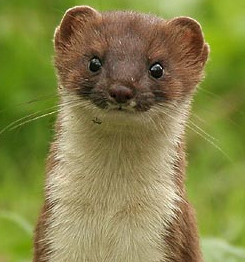
Stoat (Photo: @socialspace)
The stoats may have reached the islands via farm produce such as hay or possibly through a deliberate release. There have been unconfirmed sightings at locations on mainland Orkney and South Ronaldsay, and confirmed sightings from Wideford Hill.
The live stoat trapping and relocation project is being carried out by Scottish Natural Heritage (SNH); RSPB Scotland; the Scottish SPCA and Orkney Field Club. Volunteers have been trained to carry out the trapping in line with strict guidelines on animal welfare.
Stoats are widespread and common throughout mainland Britain and Ireland but until this year had not been recorded in Orkney.
These lithe hunters typically feed on birds and small mammals so their presence in Orkney could have a devastating effect on rich and diverse birdlife such as nesting waders, terns and gulls.
This abundance and variety of birds in Orkney attracts a great number of visitors to the islands, who generate a significant amount to the local economy each year.
Among the stoats’ potential prey is the Orkney vole which is not only unique to Orkney but also a vital source of food for important populations of hen harrier and short-eared owl.
Under the scheme all trapped live animals will be transported safely to the mainland by the Scottish SPCA where they will be transferred to the charity’s Wildlife Rescue Centre near Dunfermline, Fife, for temporary care before being released at carefully selected locations.
Gail Churchill from SNH’s Orkney office stressed: “It is far from certain how the stoats have managed to reach Orkney but it could be through deliberate release or accidentally – for example with one or more stoats arriving in a load of imported hay.
“We also realise that some folk might think the stoats do a good job by keeping the rabbit population down, but their presence here puts our native wildlife at risk and it is important we do something about it.
“If the stoats have only just arrived in Orkney this year it gives us the opportunity to try and stop them spreading by live trapping and moving them back safely to appropriate areas in mainland Scotland.
“It currently appears this is a small-scale problem and we are hopeful this combined effort from all partners will be sufficient to lift the threat. However, if it becomes apparent that there is a larger or more widespread population of stoats in Orkney, the partners involved will need to reassess the situation and consider the appropriate course to take.
“Orkney’s natural heritage, especially our native birds and wildlife, are important assets and attract many visitors each year who contribute to the islands’ economy. This is reason enough for everyone to be concerned about this threat and help remove it quickly.
“The welfare of any captured animals is of utmost importance and we are working with the Scottish SPCA to ensure that the stoats are handled and transported with the minimum amount of stress to the animal.”
Colin Seddon, Scottish SPCA Wildlife Rescue centre manager, said: “The locations will be chosen for their ability to provide a suitable habitat and prey for the stoats without adversely affecting the local ecosystem.
“The sites will also be selected to ensure that the stoats are not released in an area where they would be persecuted or where they could harm game birds.”
Dr Paul Walton, head of species and habitats at RSPB Scotland, said: “The arrival of stoats on Orkney is cause for great concern. Mammal predators introduced, deliberately or accidentally, onto islands where they do not occur naturally is a major cause of extinction among birds and other wildlife.
“Stoats are wonderful creatures, but it is essential that they are not allowed to escape and establish on islands with important ecosystems. This highlights the urgent need for the new Scottish Wildlife and Natural Environment Bill to deliver strong and comprehensive legislation on invasive non-native species.2
The Orkney Field Club Committee met recently and was informed of the stoats’ issue. Roger Davies, the club chairman, stressed: “All concerned were strongly supportive of SNH’s intention to take action quickly.
“In particular considerable concerns were raised about the potential impact of an unchecked stoat population on the numbers and indeed survival of our unique Orkney voles; in turn, of course, the voles support the hen harrier and short-eared owl populations.”
If stoats remain in Orkney, the population and distribution could increase quickly as each female can have a litter of between six and 12 young. Female kits born one year can produce offspring the next. The female feeds the kits for up to 12 weeks, by which time they are developing into efficient hunters.
